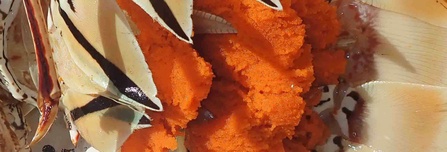WHAT TO BRING
Be sure to visit the TIPS AND TRICKS page!!
About Flies

I used to write that there is no “best” fly. However, there is one. Over the years, a #4 pearl Gotcha in bead chain has proven to be the best fly (pictured right). What’s more, there are numerous versions. A Gotcha tied with a couple of silly legs in root beer and a gold mylar tail is an excellent fly.
You could ask any guide on Andros what the best fly is, and each one will tell you something different. There are hundreds of variations that work. Bonefish are not particular like trout, where matching the hatch is critical. Here are some suggestions to give you an idea of what to bring.
Over the years, I’ve posted more flies than you can shake a rod at. Let’s keep it simple, most of the fly content on this page has been deleted. If I were going fishing today, I would drop a couple of any of the flies pictured on this page in my front pocket, along with some tippet, an extra leader, and some clippers.
I’d throw any one of them with confidence. Specifically, my first choice would be a size 4 Gotcha, followed by the Ververka’s Mantis Shrimp (pictured right) and a couple of Fitz flies (below). I’d throw the Fitz fly first knowing I have two excellent backup patterns. I have caught some big fish on the Fitz. If none of them work, nothing will.
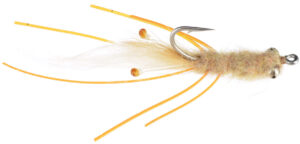
Hook Sizes
The standard hook size for a bonefish fly on South Andros is a #4 hook with bead chain eyes, period, end of story. With caveats…
Bahamas bonefish are big, unlike the Belize and Mexican dinks. Huge fish swim the waters around Andros. A #2 was the suggested size in the past. I threw flies tied with #2 hooks for years and find them to be very effective. A #2 hook is not too large.
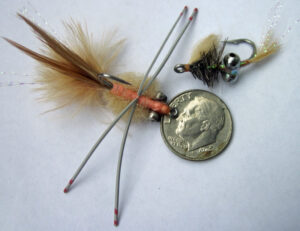 Bring a few flies in size 6 if you’re fishing during the winter months, in case the water is unusually cool or a cold front has just passed. Cooler water slows the fish down. The #6 crab flies (pictured left) work well on chilly days. Guests reported no refusals.
Bring a few flies in size 6 if you’re fishing during the winter months, in case the water is unusually cool or a cold front has just passed. Cooler water slows the fish down. The #6 crab flies (pictured left) work well on chilly days. Guests reported no refusals.
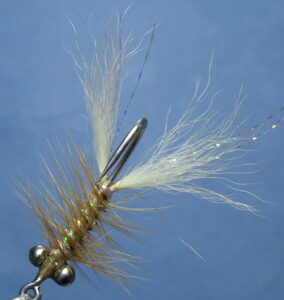 Bring the usual suspects in white, pink, pearl, brown, and tan in #4’s; #2’s will work also. Crab patterns are effective. Greg’s Flat Fly is a good fly. Finally, there’s no need to worry too much about matching the exact color; tan calf-tail claws with tan rather than green body will work, or a pearl body with white hackle and claws….whatever. (pic right)
Bring the usual suspects in white, pink, pearl, brown, and tan in #4’s; #2’s will work also. Crab patterns are effective. Greg’s Flat Fly is a good fly. Finally, there’s no need to worry too much about matching the exact color; tan calf-tail claws with tan rather than green body will work, or a pearl body with white hackle and claws….whatever. (pic right)
WEIGHTED FLIES
You’ll need some heavily weighted flies for two reasons. First, the shoreline flats can become too hot, with temperatures exceeding 85 degrees. Bonefish are comfortable in water 70 to 85 degrees. If the water feels like you’re wading in your own piss, the flat will be vacant of fish. Your guide will look for cooler water near the deeper channel edges and ocean-side flats.
You might find yourself FISHING WATER TWO TO THREE FEET DEEP. Don’t waste your time throwing a #4 bead chain fly. It will float in the water column and never sink to the bottom at that depth. A #2 weighted fly will get you there quickly. Bonefish are bottom feeders. It’s crucial your fly is on the bottom.
Second, you might find yourself fishing in a 20mph wind or more. A weighted fly will help roll your leader out when casting into the wind. A light fly can frustrate you enough to snap a rod over your knee.
Don’t tie flies?
Go here, great prices… https://www.discountflies.com/category/bonefish_flies.html . Get yourself some Gotchas and Mantis Shrimp patterns, and you’ll do well. Sort by bestselling. The Bonefish Scampi, Spawning Shrimp, DF Spawning Shrimp, Bearded Mantis Shrimp, Squimp, Gotcha Gold, and Silly Leg Gotcha are other good flies on the same website.
Some glorified spawning shrimp patterns are the latest rage and excellent flies but are a bit pricey. Feather-Craft has been around for a long time. https://www.feather-craft.com/puglisi-spawning-shrimp The guys at the shop provide excellent service and have all afternoon to talk to you if you have questions.
For the Fly Tyer
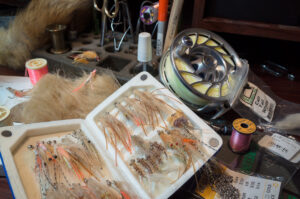

Fitz Fly…above.
The Fitz is an excellent fly and quick to tie. Don’t bury the fly under a thick wing; keep it sparse. That applies to most bone flies. You wouldn’t bury a beautiful dessert under a pile of whipped cream, would you? The body is nothing but a couple of wraps of fluorescent orange flat waxed thread with a coat of UV Knot Sense to toughen it up and add some volume.

KEEPING IT SIMPLE
You’d do just fine if you brought nothing but the flies above.

Making it Hard
The flies above are also very effective. However, they can be time-consuming to tie, and you can spend a chunk of change buying “special” materials for this style of fly. All of these flies’ bodies were tied using a dubbing loop with rabbit or arctic fox mixed with various Polar Ice Dub colors.
Before you start to tie the fly, roughen the hook shank with some sandpaper and give it a good coat of cement. The final step is wrapping the shank with your dubbing loop. Coat the shank heavily before doing so. Lastly, once you have tied your loop, use a piece of velcro to fluff up and trim the dubbing. Cut the bottom flat and coat bottom with several drops of cement.
I don’t usually tie the same fly twice; it’s an attention issue. You’ll notice each fly is different. Most are shrimp patterns. The three barred flies with orange eyes are a version of the Lefty’s Craft Fur Shrimp.
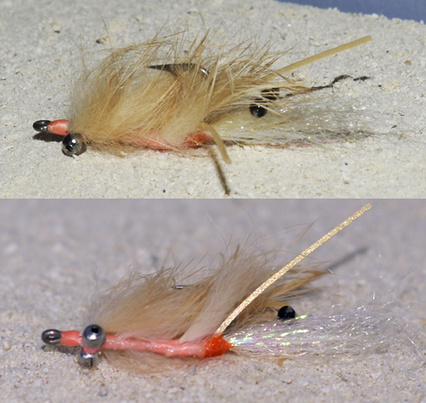 The Peterson’s Spawning Shrimp pictured left has also been tied in dozens of versions. This particular fly was tied by Eric Peterson himself….in case you were wondering what the original looks like.
The Peterson’s Spawning Shrimp pictured left has also been tied in dozens of versions. This particular fly was tied by Eric Peterson himself….in case you were wondering what the original looks like.
If you dig around on the web, you can find endless resources on tying any of these bonefish flies.
Hints to Tying an Effective Andros Bonefish Fly
How to tie Ververka’s Mantis Shrimp here.
Most flies are just variations of the Gotcha fly. The Gotcha fly is actually a version of the Charlie fly, but with a tail. Furthermore, a Super Gotcha fly is just a Gotcha fly with silly legs. A Bunny Gotcha is a Gotcha with a rabbit fur wing; add a beard and eyes to the tail, and it’s a spawning shrimp.
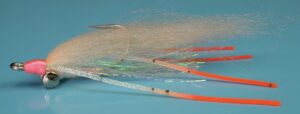
Don’t worry about the specific materials or patterns, it is not important. Have fun and mix it up. You’ll get more satisfaction knowing you caught that bone on a fly unlike any other: and you tied yourself.
Here are some helpful hints for tying an effective South Andros bonefish fly. There are two color groups: the pinks/pearls and the naturals like brown, tan, or blonde. The bones seem to really like rubber legs on anything. On the natural colored flies, be sure to tie on a few strands of copper or gold flash.
One group of eight tossed nothing but the fly below the entire week and killed the bones. It’s tied in nothing but gold. We thought it so ugly we called it the Phyllis Diller…..respectfully. One of my guides, Pap, speaks highly of a Gotcha with a gold tail.

Critters try to camouflage themselves to blend in with their environment. Light bottom, light fly. Dark bottom, dark fly. In the end, don’t worry about it.
As a safety precaution, be sure to bend your barbs and always wear your glasses! It’s all fun and games until someone gets an eye poked out.
What’s up with the orange accent on so many flies?
Shrimp, crabs, mantis shrimp, and other bottom-dwelling critters carry their eggs under the tail until maturity. The eggs are colored in shades of pink, orange, yellow, brown, and light grey to black. The picture right is lobster eggs. Caught in the open, I’ve seen fish harassing female lobsters carrying eggs. There’s a particular crab called a decorator crab that does a great job camouflaging themselves by laying whatever they find in their surroundings on their backs. I once caught a small dime-sized crab covered in shell-pink-colored eggs. I doubt that crab made it through the day.
Fly Rods
Some bring 6 and 7 weights. They are too light and not recommended. Leave them at home.
If you can throw a tight loop and have a good double haul, an 8 weight is fine up to a 15 mph wind but if the wind picks up to 20 mph, you’ll wish you had a 9 weight. Bring an 8 weight and a 9 weight. The odds are very good that you’ll be casting in 10 to 20-mph winds. Some fishermen like to overline their rods by one weight. Whether you are experienced or a beginner a 9wt rod loaded with a 10wt line is a deadly tool on a windy day. Think of it as the difference between throwing a baseball or a wiffle ball against the wind.
Some fishermen show up carrying nothing but an 8-weight. That’s fine; it will work but why make it harder than it is? You’ve come a long way and spent a chunk of change. The wind doesn’t always blow, but it might when you’re here.
Let’s beat this dead horse one more time…..COME EXPECTING 10 to 20 MPH WINDS!
Fly Line
Weight forward floating line.
Leaders
Generally, a 10ft leader works well. Some store-bought leaders have weak butts that collapse onto your fly line when pushed against a strong wind. Add a couple of feet of 30lb or 40lb hard mono to your fly line, then tie your leader to that. You can also build your own leaders with hard mono or fluorocarbon. There are formulas regarding the proper length for each section. It’s all overkill. Equal parts or lengths work just fine. A good high wind leader is 3ft of 40lb, 3ft of 30lb, then 3ft of 20lb. A good all-around leader can be built using 3ft of 30lb, 3ft of 20, then 3ft of 16lb.
Tippet
Use no less than 16lb to 20lb fluorocarbon tippet. You’ll kill fish using 10-12lb. See the Tips and Tricks page for more on that.
Seems like every week a fisherman will come in at the end of the day and say they lost the biggest bone of their life. I ask what tippet they were using. It’s always 10-12 lb. Ten to twelve-pound tippet is too light.
You can buy a lifetime supply of fluorocarbon on a 300-yard spool from Walmart for less than you’ll pay for a single 10-yard spool of fluorocarbon that says “tippet” on the spool. Seaguar Fluoro is considered the best.
I have a guest who has been coming every year since I opened. He consistently catches more fish than everyone in the lodge. He has been on the front page of my website three times. Twice with the biggest fish of the year and another time with the most fish ever caught in a day, 50 fish. He uses a 25lb fluoro tippet.
Every time I go fishing, I hope to catch the fish of a lifetime. I don’t want to be messing around with 10lb tippet. If you’re fishing the mangrove edges you won’t stop even a small fish from ripping through the mangroves. Even worse, an overplayed fish is a dead fish. That splashing you hear a quarter mile out is the fish you just released getting chewed up by a shark.
Fly Reels
A large arbor with 200 yards of 20-30 lb backing. Nearly every fish you hook will be into your backing.
Rain Gear
A raincoat is the most forgotten item and one of the most important. I do not have a closet full of loaners. Remember to bring a raincoat. It is REQUIRED, not optional!! Light and breathable. Bring your rain gear with you on the boat daily, no matter how clear it looks. Squalls pop up quickly and the boat ride can be wet.
Wading boots
Wade boots are also REQUIRED and commonly forgotten. Some flats have razor sharp marl. Don’t forget to bring your socks or neoprene booties. A little sand in your boots without the socks will rub your feet raw. Sand guards can prove helpful.
Most fishermen wear lace-up wade boots. They provide good ankle support if you find yourself wading across a hill and hole bottom. But they do feel like boots. Neoprene zip-up boots with firm rubber soles are very comfortable but lack ankle support.
No, sandals are not suitable for wading. The sand will rubs your feet raw,
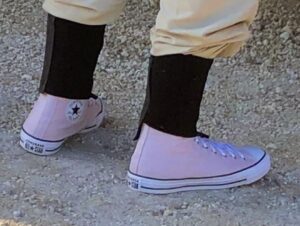
It takes some balls to wear these.
Wading Pants
Required!!!! The thin wade pants, some call shants, with zip-off leggings, don’t work. Flies will bite through them. Besides, the baggy pants and oversized long-sleeved button-up shirt look is dated.
I’m dressing my guides in the newer long sleeve pullover shirts and ripstop nylon pants the flies cannot bite through. Although I try to avoid promoting products, I must say that these ripstop pants are impressive. They last twice as long, dry just as quickly, are equally cool, more stylish, and cost less than those baggy “wade pants”. Furthermore, they are impervious to bites from flies. Your choice of the number of pockets; loose, regular, or slim cut. That is the problem, too many styles to choose from. One style has 20k [email protected] stars. I believe they are quite popular with the prepper crowd. My best advice would be to find a pair with 3% elastane in the fabric, it has a little stretch and makes it easier to lift your legs into the boat and won’t bind up the boys. CLICK HERE
Chest, Back, or Fanny Pack
You may be wading for hours and the boat will be just a spec on the horizon. Be sure to bring a wading pack to carry your flies, leaders, tippet, clippers, a water bottle, a camera, etc.
Tools
Bring long-nose pliers, hemostats, knot tying tool, snips, hook sharpener, and dehooker.
I carry a fingernail clipper and a dehooker, that’s it. I’d like to see more fishermen carrying a dehooker. They are simple to use; slide the dehooker down the leader to the hook bend and release the fish without touching it.
If you do not have a dehooker, and the fish is hooked in the lip, slide your hand down the tippet, grab the shank of the hook, and give it a shake. There’s no need to handle the fish. Some fishermen come in at the end of the day covered in bonefish slime. As a rule, if you don’t want a picture do not handle the fish. Once touched you’ve broken the slime and the scent is released. Sharks are like a hound dog on a raccoon. I believe most handled fish do not survive.
I do realize that sometimes the fish has taken the fly so far down its throat that a death grip and surgery is required. You win some, lose some.
Dehooker
There are several models. The dehooker below works great; I give them to the guides. They’re easy to find at Walmart, Ace, or sitting on the check-out counter at a Fishing Store. Dirt cheap, two bucks.
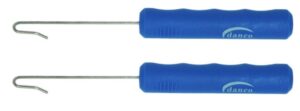
Getting the Fish Pic
If you would like to take a picture of a fish, keep it in the water until ready. Do not put your fingers into the gills of the fish, not cool! Wet your hands and quickly lift the fish from the water. Hold the fish with your arms extended. The closer that fish is to the camera lens, the bigger it will appear. Take the photo, and release the fish back into the water immediately. You may have to cradle the fish long enough for it to regain its strength.
Sunglasses
Polarized with amber or copper lenses.
Hat
REQUIRED!!! Black under the brim, it’ll absorb light rather than reflect it off the water. A full-brim is better than a baseball hat. Some guests are missing chunks of their ears and nose from getting precancerous sun damage cut off.
Bugs and Bug Spray
I get bitten quite often on a daily basis. I’m used to it, I don’t think they are that bad. But, I do use Off bug spray during calm mornings and evenings when I sit on the porch. However, some guests have severe allergic skin reactions to the bug bites.
If the wind is down, when sitting on the seaside porch at the end of the day, be sure to apply OFF bug spray to exposed skin. More specifically, from your knees down if wearing shorts, and on your arms if wearing a short-sleeved shirt.
Bring some bug spray; 25% to 50% deet is good, 100% deet is excessive. Buy it in an aerosol can. Avoid the pump bottles, they do not work properly when turned upside down.
Doctor Flies
 There’s a biting fly on Andros. You can wear shorts on the boat in December and January, but you must wear wade pants the rest of the year!! I used to get my first bite in March in previous years, which was a clear sign of their return. Sadly, the Doctor (Yellow) flies appear in February now. They are like giant deer or horse flies and only the females bite…Hard! The bites cause large and persistent local numbness, itching, and swelling.
There’s a biting fly on Andros. You can wear shorts on the boat in December and January, but you must wear wade pants the rest of the year!! I used to get my first bite in March in previous years, which was a clear sign of their return. Sadly, the Doctor (Yellow) flies appear in February now. They are like giant deer or horse flies and only the females bite…Hard! The bites cause large and persistent local numbness, itching, and swelling.
Pants are strongly recommended from February through November. Even so, the doctor flies will still bite through your pants where they are wet and sticking to your calf. Wearing knee-high socks will keep the flies from biting through. Avoid dark colors. The flies are especially attracted to black due to the heat it generates. Doctor flies are easily killed, they are much slower than the common house fly. Don’t brush them away, they are belligerent and will be back in seconds. Smack them hard! If not, they’ll fly back and hit you again.
Wasps
 There is a green Sand Wasp that feeds on the Doctor fly. The wasp is twice the size of a Doctor. Bahamians call them a Drummer Bee. (From Wikipedia – The type of prey captured tends to be consistent within each genus, with flies being the most common type of prey taken. Nests are typically short, simple burrows, with a single enlarged chamber at the bottom which is stocked with freshly-killed prey items for the developing wasp larva; the egg may sometimes be laid before the chamber is completely stocked.)
There is a green Sand Wasp that feeds on the Doctor fly. The wasp is twice the size of a Doctor. Bahamians call them a Drummer Bee. (From Wikipedia – The type of prey captured tends to be consistent within each genus, with flies being the most common type of prey taken. Nests are typically short, simple burrows, with a single enlarged chamber at the bottom which is stocked with freshly-killed prey items for the developing wasp larva; the egg may sometimes be laid before the chamber is completely stocked.)
Doctor flies have evolved to make themselves scarce when the wasp is around. If a Sand Wasp is in the boat leave him bee, he is not aggressive.The wasp searches for doctor flies by hovering around you, much like a hummingbird. He is your buddy; he’s your pal. You’ll see the wasp attack a Doctor fly on your pant leg and fly away, making a crunching sound.
I’ve yanked the wing off a fly or two, tossed them on the bow and watched the wasp snatch them up. I actually had a wasp take one from my fingertips. Yeah, my head ain’t right and I’m easily entertained.
No-See-Ums
There’s a tiny biting gnat called a No-See-Um. When the wind is up, they can’t fly and don’t bother you. If you wear a short-sleeved shirt and shorts while sitting on the porch at the end of the day and the wind is down or not blowing, they will light you up! Unfortunately, Some guests are allergic to the bite and by the end of the week, they look like they have chicken pox. One guest thought the lodge had bed bugs and wanted to see the doctor after I repeatedly reminded him to apply bug spray on the porch.
In addition, I’ve made a note of the no-see-ums here on the website. On arrival, I’ll remind the guests again in the orientation speech. There’s nothing else I can do but throw you a tube of hydrocortisone anti-itch cream or give you a couple tabs of Benadryl…. exactly what the doctor will do.
And yes, there are mosquitos and they are aggressive. They are scarce during the cooler months, or the wind is up, but thick after a rain.
Spin rods, reels, tube lures, and lures for Cuda
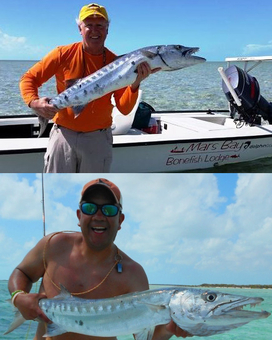
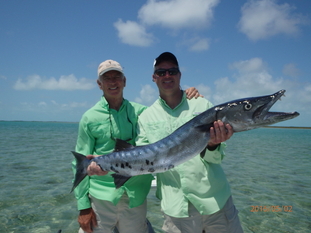
All Barracuda get a complimentary boat ride back to the dock. Bahamians love to eat them.
Although some fishermen do, there are better tools than a fly rod for Barracuda. It’s difficult to strip fast enough. Be sure to have a trailing hook on your fly.
Most fly fishermen bring a spin rod for Barracuda that frequent the flats. Ask the guide to carry it for you while wading. A Green tube lure is the best lure. Be sure to buy the tube lure with a treble hook near the rear of the tube. Not all tube lures do. Topwater floating plugs work well; Mirror lure, Yozuri, etc. Throw it to either side, past the Bari, and reel as fast as possible. They’ll hit it so hard and fast you’ll wet your britches.
You’ll need a six to seven-foot rod with a 10-30lb line rating, medium to fast action, and a Shimano or Penn 4000 series reel or equivalent. Use 20-30 lb test braid, make sure the spool is full. Bring some wire leader.
TARPON AND PERMIT
There are much better places to fish for Tarpon and Permit. Sightings are very few and far between. We have never had a fisherman catch either species. Leave the 10wt rod and Tarpon-Permit flies at home.

